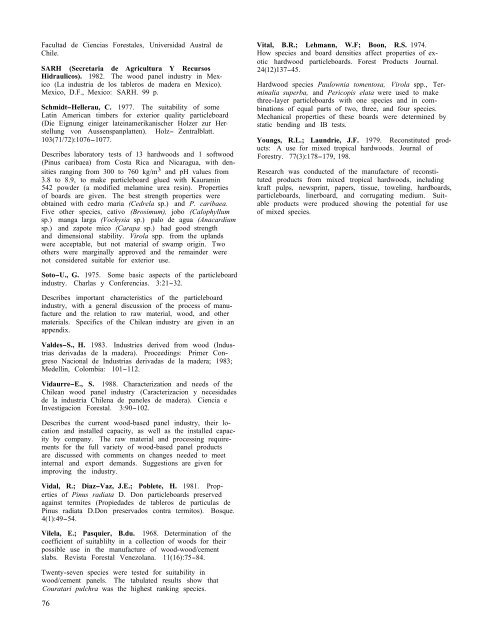Forest Products from Latin America. Annotated Bibliography of ...
Forest Products from Latin America. Annotated Bibliography of ...
Forest Products from Latin America. Annotated Bibliography of ...
You also want an ePaper? Increase the reach of your titles
YUMPU automatically turns print PDFs into web optimized ePapers that Google loves.
Facultad de Ciencias <strong>Forest</strong>ales, Universidad Austral de<br />
Chile.<br />
SARH (Secretaria de Agricultura Y Recursos<br />
Hidraulicos). 1982. The wood panel industry in Mex-<br />
ico (La industria de los tableros de madera en Mexico).<br />
Mexico, D.F., Mexico: SARH. 99 p.<br />
Schmidt-Hellerau, C. 1977. The suitability <strong>of</strong> some<br />
<strong>Latin</strong> <strong>America</strong>n timbers for exterior quality particleboard<br />
(Die Eignung einiger lateinamerikanischer Holzer zur Her-<br />
stellung von Aussenspanplatten). Holz- Zentralblatt.<br />
103(71/72):1076-1077.<br />
Describes laboratory tests <strong>of</strong> 13 hardwoods and 1 s<strong>of</strong>twood<br />
(Pinus caribaea) <strong>from</strong> Costa Rica and Nicaragua, with den-<br />
sities ranging <strong>from</strong> 300 to 760 kg/m 3 and pH values <strong>from</strong><br />
3.8 to 8.9, to make particleboard glued with Kauramin<br />
542 powder (a modified melamine urea resin). Properties<br />
<strong>of</strong> boards are given. The best strength properties were<br />
obtained with cedro maria (Cedrela sp.) and P. caribaea.<br />
Five other species, cativo (Brosimum), jobo (Calophyllum<br />
sp.) manga larga (Vochysia sp.) palo de agua (Anacardium<br />
sp.) and zapote mico (Carapa sp.) had good strength<br />
and dimensional stability. Virola spp. <strong>from</strong> the uplands<br />
were acceptable, but not material <strong>of</strong> swamp origin. Two<br />
others were marginally approved and the remainder were<br />
not considered suitable for exterior use.<br />
Soto-U., G. 1975. Some basic aspects <strong>of</strong> the particleboard<br />
industry. Charlas y Conferencias. 3:21-32.<br />
Describes important characteristics <strong>of</strong> the particleboard<br />
industry, with a general discussion <strong>of</strong> the process <strong>of</strong> manu-<br />
facture and the relation to raw material, wood, and other<br />
materials. Specifics <strong>of</strong> the Chilean industry are given in an<br />
appendix.<br />
Valdes-S., H. 1983. Industries derived <strong>from</strong> wood (Indus-<br />
trias derivadas de la madera). Proceedings: Primer Con-<br />
greso Nacional de Industrias derivadas de la madera; 1983;<br />
Medellin, Colombia: 101-112.<br />
Vidaurre-E., S. 1988. Characterization and needs <strong>of</strong> the<br />
Chilean wood panel industry (Caracterizacion y necesidades<br />
de la industria Chilena de paneles de madera). Ciencia e<br />
Investigacion <strong>Forest</strong>al. 3:90-102.<br />
Describes the current wood-based panel industry, their lo-<br />
cation and installed capacity, as well as the installed capac-<br />
ity by company. The raw material and processing require-<br />
ments for the full variety <strong>of</strong> wood-based panel products<br />
are discussed with comments on changes needed to meet<br />
internal and export demands. Suggestions are given for<br />
improving the industry.<br />
Vidal, R.; Diaz-Vaz, J.E.; Poblete, H. 1981. Prop-<br />
erties <strong>of</strong> Pinus radiata D. Don particleboards preserved<br />
against termites (Propiedades de tableros de particulas de<br />
Pinus radiata D.Don preservados contra termitos). Bosque.<br />
4(1):49-54.<br />
Vilela, E.; Pasquier, B.du. 1968. Determination <strong>of</strong> the<br />
coefficient <strong>of</strong> suitablilty in a collection <strong>of</strong> woods for their<br />
possible use in the manufacture <strong>of</strong> wood-wood/cement<br />
slabs. Revista <strong>Forest</strong>al Venezolana. 11(16):75-84.<br />
Twenty-seven species were tested for suitability in<br />
wood/cement panels. The tabulated results show that<br />
Couratari pulchra was the highest ranking species.<br />
76<br />
Vital, B.R.; Lehmann, W.F; Boon, R.S. 1974.<br />
How species and board densities affect properties <strong>of</strong> ex-<br />
otic hardwood particleboards. <strong>Forest</strong> <strong>Products</strong> Journal.<br />
24( 12) 137-45.<br />
Hardwood species Paulownia tomentosa, Virola spp., Ter-<br />
minalia superba, and Pericopis elata were used to make<br />
three-layer particleboards with one species and in com-<br />
binations <strong>of</strong> equal parts <strong>of</strong> two, three, and four species.<br />
Mechanical properties <strong>of</strong> these boards were determined by<br />
static bending and IB tests.<br />
Youngs, R.L.; Laundrie, J.F. 1979. Reconstituted prod-<br />
ucts: A use for mixed tropical hardwoods. Journal <strong>of</strong><br />
<strong>Forest</strong>ry. 77(3):178-179, 198.<br />
Research was conducted <strong>of</strong> the manufacture <strong>of</strong> reconsti-<br />
tuted products <strong>from</strong> mixed tropical hardwoods, including<br />
kraft pulps, newsprint, papers, tissue, toweling, hardboards,<br />
particleboards, linerboard, and corrugating medium. Suit-<br />
able products were produced showing the potential for use<br />
<strong>of</strong> mixed species.
















